Buddhist Home Retreat: What the Teachers Say About the Home Retreat Practice for Busy People Who Can’t Attend Extensive Retreats
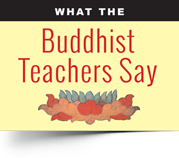
Home retreat practice can never replace the experience, benefits and potential realizations of group practice retreats and extensive solitary retreat. There is something unmistakably powerful in uninterrupted group or solo practice in a place removed from our “ordinary lives.”
In Zen Buddhism, silent retreat is a very important practice. In Vajrayana Buddhist practice — where much of the practice is designed to help us transform “ordinary perceptions” — the extensive practice and mantra retreat is considered a must, at least once in a practitioner’s lifetime. Often, it’s even one of the commitments taken with empowerment by a teacher. Counted mantra retreats, especially, ending in a Fire Puja, are treasured practices in Tibetan Buddhism. They strengthen the student’s practice, enabling self-initiation and purification practices that can truly empower practice.
In ancient times, extensive weeks-long, months-long or years-long retreats were a matter of course even for many lay people; a question of when, not if. Years-long retreats were celebrated as solo practitioners went into seclusion to focus exclusively on their practice, often with the support of a patron or family. Weeks-long teaching and mantra retreats in a group are strongly conducive to the transformation of the ordinary. Similarly in Zen or Chan, the retreat “away from our ordinary lives” is very powerful in helping us meditate with — hopefully — more clarity and insight.

What About Today’s Busy Lay Buddhists?
In modern times, sadly, with full work schedules, some people working two jobs, raising families, and other obligations, it’s difficult enough to commit a weekend to a retreat. Even saving enough vacation time for a three or four week formal retreat can be difficult — as can explaining to your family why you are using your vacation time in a retreat away from your family. For this reason, serious lay practitioners often make a commitment to themselves (and their teacher) to put off the extensive retreat until the kids are grown up, or retirement provides the opportunity to get away, or just simply the household is financially stable enough to take time away. Yet, in today’s hectic and uncertain world, it’s possible that day many never come. The practice put off, is often the practice never completed.

The most venerable Zasep Tulku Rinpoche, spiritual head of several meditation centres in North America and Australia, at a teaching on La Gug, emphasized that an ideal time for extensive retreat might be when children leave the nest: “Another term we use in the West — “Empty Nest Syndrome.” [Audience chuckles] Why is it a syndrome? Your children are gone, you should be happy! [Audience laughs] They go to University, now I can do what I want to do! I can study, I can go back to University myself, or meditate, do retreats…”
Link to video on La Gug with Venerable Zasep Tulku Rinpoche:
What if We Never Find Enough Time?
Although it may sound ideal, many Empty Nesters somehow never find the opportunity for retreat. As we age, our stamina might be lower. Our health may not be as vigorous as in youth. Arthritis may prevent us from even sitting in the Vajra or lotus posture. And, increasingly, adult children are moving back into the nest.
One solution, advocated more and more in today’s busy world, is the home retreat — which can be particularly powerful for counted mantra retreats. Not to be confused with daily practice or meditation, the home retreat requires a similar commitment as the intensely focused remote retreats; something on the magnitude of 100,000 to 400,000 mantras in formal retreat. To develop that level of intensity, practice sessions will be longer than you might otherwise consider. Not all teachers even recommend the practice (check with your own precious teacher.) Some teachers, however, are using skillful means to encourage home retreats where the remote weeks-long retreat is not feasible.

Not all teachers would even consider this an option for their students, but many now seem to suggest it to busy lay students. Regardless, your teacher would help you plan your commitment and retreat activity, unless you’re creating your own retreat just for your own benefit as a discipline. It is always important to discuss with your teacher.
Lama Zopa Rinpoche: 100 Million Mani Retreat for Home Practitioners
Lama Zopa Rinpoche, spiritual head of FPMT, recognized this difficulty when he suggested the 100 Million Mani Retreat and encouraged it for “home retreat” use.
Lama Zopa asked the Chenrezig Institute to conduct a 100 Million Mani Retreat — which entails daily sadhana and meditating on the “Om Mani Padme Hum” mantra, repeating the mantra at least 100 Million times collectively.
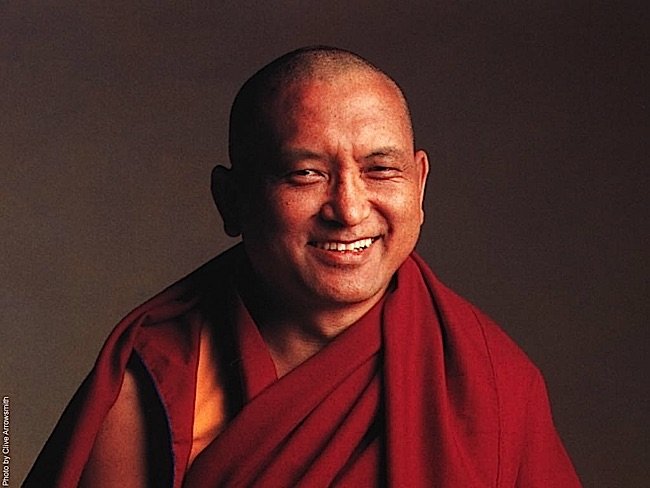
As quoted in Mandala Magazine: “With Rinpoche’s permission, CI opened up the retreat to “home retreaters” in an effort to adapt the retreat to busy Western lifestyles and time constraints and to ensure that the maximum involvement of practitioners could occur.” [1] This is done through “pledges” from home users. At that time, the feature article mentioned Lama Zopa Rinpoche will lead the 100 Million Mantra Retreat… Hundreds of students from all over the world have already registered for this event with many others opting into the home retreat option. Students can participate at any level to receive the blessings of the millions of mantras.” The practice involved a short daily sadhana, and pledge commitment to a specific number of mantras in the home.
Melissa Robinson, Co-Director of Dorje Khyun Dzong: “Know what you hope to accomplish”
Before embarking on any retreat, you should know why you are going and what you hope to accomplish,” writes Melissa Robinson, Co-Director of Dorje Khyung Dzong Retreat Centre. “Equipped with the detailed instruction for specific practices, they go on retreat to attain enlightenment, and many people plan long retreats for that express purpose. For most of us though, our early retreats are envisioned as a time to develop a deeper appreciation of our current practice, or sometimes to get started on a new one. Other times we might seek to accomplish a specific number of mantras or to complete a retreat cycle such as Chakrasamvara or Vajrakilaya.” [3] Although her suggestions are focused on formal retreat in a retreat centre, they make sense in the context of home retreat as well.
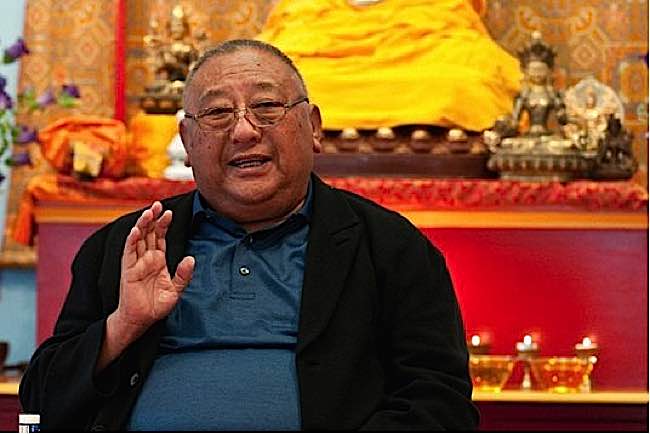
Gelek Rimpoche: “Retreat can be done in a group or individually… in your home”
In teachings on Vajrayogini, Gelek Rimpoche taught a home retreat method. [2] Although this was specific to Vajrayogini — and only for initiated students — the fact that a Highest Yoga Tantra practice could be performed at home is inspiring.
Gelek Rimpoche said: “It is always nice to do retreat [to get closer to the deity]. At least once or twice in your life time [laughs] you should do this retreat. Really, you should do that. There are people who do one every year or even every six months. I very much admire them. It does not take very long. This retreat can be done in a group or individually. You can do it in your home. There is not much difficulty.”
In this case, the mantra counting retreat is to be immediately followed by a Fire Puja, so students would calculate how long to complete the commitment at home, so that they would finish on time for the next Fire Puja, which is often led by a teacher, but can also be done solo at home.

Rimpoche told the story of two practitioners who did an extensive counting retreat, calculating for date of the next planned Fire Puja. Rimpoche said, “I could not return back for a very long time after they had finished the retreat and therefore they had to continue to say the long sadhana every day until an opportunity came up to do a fire puja. This happened when Zasep Rinpoche did one in Ithaca several months later.”
In this case, a formal counting retreat for a Higher Tantra, (and this applies even when the counting is completed) requires the daily sadhana — usually the longest version — and counting continues with full daily continuity until a Fire Puja can be organized. Even if doing your own solo Fire Puja at home, you need to make preparations. With this approach, busy Westerners can adapt practice methods while still meeting commitments to the retreat.
NOTE: Please see Linda’s comment to this article. In her practice she also does her own fire pujas. Check with your teacher.
How to Do a Mantra Retreat Alone at Home
Gelek Rimpoche also had some very important instructions for home retreat. While this was specific to one Higher Yoga practice, these basic principles would really apply to any practitioner hoping to benefit from a home retreat.
“If you do that retreat alone, you should do at least the first 100 000 mantras on the same cushion. Every day within 24 hours, you have to do at least one session and for that you have to say at least 100 mantras and do the complete long sadhana.”

Rimpoche also compared the pace of a private home retreat and a group retreat. “If you do a private retreat leisurely in your own house, it may take up to two months. In a group retreat, it may take three or four weeks. Even in a group, people may not do all the sessions together.”
Good advice for any practice, Rimpoche also recommended the utmost in cleanliness in the meditation area: “The retreat place should be clean and neat and tidy. There should be no nesting. It is a retreat area, not your sleeping place. If you do the retreat in your own home, you cannot use your bed as a cushion to sit on. You need a separate spot. If possible, you should also not do your other sadhanas and practices on the retreat cushion. You have to do them separately.”
Calculating time for Mantra Counting Retreat
Assuming your teacher even endorses the home retreat, the first thing to do is calculate how much time will be needed. Generally, you add 10 per cent to any goal in mantras to allow for mistakes, although that would be specified by your teacher.
For example, if your teacher recommends a 100,000 mantra retreat, and you’d like to complete that in two months at home — versus the ten days to three weeks in formal full-time retreat — you would need to complete 1100 malas (108 mantras per mala) for 110,000 mantras. You would therefore target eighteen malas a day for a two month retreat, or twelve per day for a three month retreat. Allow the extra time for the accompanying daily sadhana for your particular practice, and meditation time.
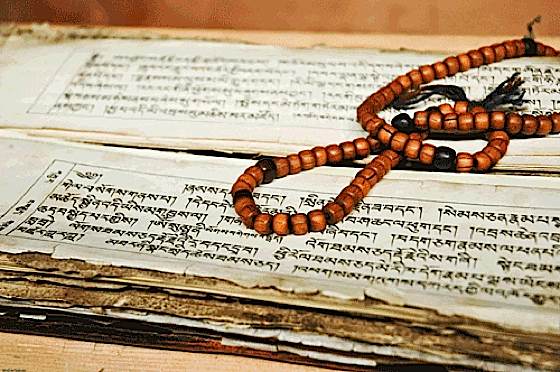
You could also calculate the length from the goal. For example, if your family and work commitments allows you only 2 hours a night for the retreat, if you allowed forty-five minutes for the sadhana, you’d have seventy-five minutes left for mantras. If you have a short mantra, such as Om Mani Padme Hum, you might be able to do a full mala very quickly. A longer mantra might require ten minutes per mala. Time yourself. If, for example, you can complete a mala in five minutes, you can manage 15 per session.
Generally, if you miss a commitments, even one, you are often coached to “start over.” And, if you are completing the retreat with a Fire Puja, you might have to keep up the same level of daily practice until there is a Puja.
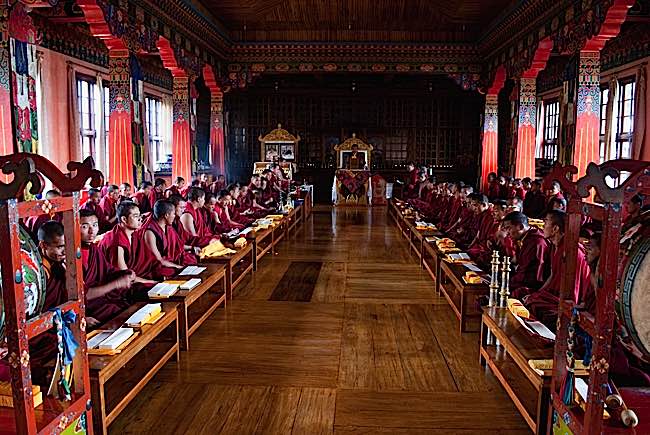
Conduct on a Retreat
The conduct on a home retreat is whatever your teacher advises, although generally you can’t go far with this advice (meant for formal retreat) from Melissa Robinson: “Consult your teacher for advice on how many sessions of practice to do each day. Most teachers recommend that you spend part or all of the first day preparing your cabin and getting used to being in retreat before beginning an eight to ten hour daily routine of practice. Newer practitioners might want to start out with fewer hours and add more after a few days.”
She also advises: “As for conduct on retreat, be honest with yourself, and do not set up unattainable goals. Define your retreat boundaries both in terms of the physical situation and your needs and then stick to them. Avoid contact with others, but seek out help if needed. Do not go on a radical diet, or give up smoking, or caffeine on retreat. To do so might add unnecessary anxiety.”
NOTES
[1] “Featured Practice: 100 Million Mani Retreat” Mandala
[2] Vajra Yogini Teachings, Gelek Rinpoche.
[3] Dorje Khyung Dzong Retreat Centre “Advice on Retreat” by Melissa Robinson, Co-Director of DKD
4 thoughts on “Buddhist Home Retreat: What the Teachers Say About the Home Retreat Practice for Busy People Who Can’t Attend Extensive Retreats”
Leave a Comment
More articles by this author

NEW MUSIC ALBUM! Four Heavenly Kings: Mantras Chanted in Sanskrit for Good Fortune, Protection, Harmony and Wisdom

4 Guardians of the World and Dharma: the Watchers of the World: the Four Heavenly Kings in Buddhism, Their Mantras and Practice
Search
Latest Features
Please support the "Spread the Dharma" mission as one of our heroic Dharma Supporting Members, or with a one-time donation.
Please Help Support the “Spread the Dharma” Mission!

Be a part of the noble mission as a supporting member or a patron, or a volunteer contributor of content.
The power of Dharma to help sentient beings, in part, lies in ensuring access to Buddha’s precious Dharma — the mission of Buddha Weekly. We can’t do it without you!
A non-profit association since 2007, Buddha Weekly published many feature articles, videos, and, podcasts. Please consider supporting the mission to preserve and “Spread the Dharma." Your support as either a patron or a supporting member helps defray the high costs of producing quality Dharma content. Thank you! Learn more here, or become one of our super karma heroes on Patreon.
Lee Kane
Author | Buddha Weekly
Lee Kane is the editor of Buddha Weekly, since 2007. His main focuses as a writer are mindfulness techniques, meditation, Dharma and Sutra commentaries, Buddhist practices, international perspectives and traditions, Vajrayana, Mahayana, Zen. He also covers various events.
Lee also contributes as a writer to various other online magazines and blogs.

















You can learn to do your own fire puja. You would receive permission to do one on your own from your teacher, of course. I’ve done a number of retreats in the Tibetan tradition at home and now do at least one every year.
Thank you Linda, that’s really helpful.
Getting out to Buddhist Retreats is a great way to take your study of Buddhism Facts to the next level, as many of us have looked at Buddhism in great depth in books, nothing can quite compare to the depth of spirituality you will reach by actually going to a monastery or a temple, and practicing with other like-minded individuals.
Despite the negatives, going to a beginners Buddhist retreat is simply the best way to begin on your path. You will be alongside other like-minded people and have guidance from some truly knowledgeable ones, who are already close to enlightenment and can guide you through the path and get you well on your way to becoming a calmer, happier and more fulfilled person.